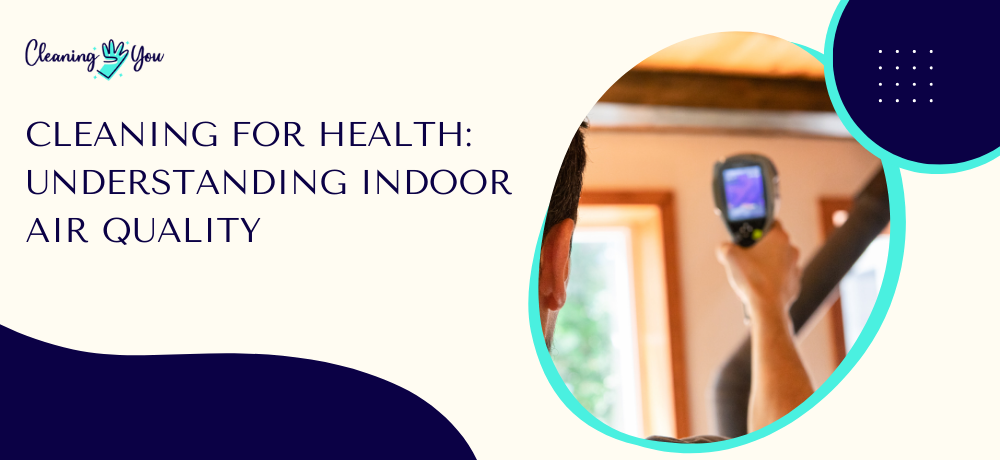
Cleaning for Health: Understanding Indoor Air Quality
- Cleaning 4 You
Our homes are our sanctuaries, providing us with comfort, safety, and a sense of well-being. We invest time and effort in making our living spaces aesthetically pleasing, but one crucial aspect often goes unnoticed: indoor air quality. The air we breathe indoors significantly impacts our health and overall quality of life. In this blog, we'll delve into the world of indoor air quality, its importance, the factors that affect it, and how we can ensure a healthier environment within our homes.
Understanding Indoor Air Quality (IAQ):
1. Definition of Indoor Air Quality (IAQ):
Indoor Air Quality (IAQ) refers to the condition of the air inside a building or enclosed space and its impact on the health and comfort of its occupants. It encompasses various factors, including the presence of pollutants, temperature, humidity, and ventilation.
2. Importance of IAQ for Well-being:
IAQ is crucial for our well-being because we spend a significant portion of our lives indoors. Poor IAQ can lead to a range of health problems, from short-term issues like allergies and respiratory irritation to long-term, potentially life-threatening conditions such as cardiovascular disease and cancer. Good IAQ promotes comfort, productivity, and overall quality of life.
Common Indoor Air Pollutants and Their Sources:
1. Dust: Dust particles, including dust mites, pollen, and pet dander, are common indoor pollutants. They originate from outdoor sources and can accumulate indoors through open windows, doors, and ventilation systems.
2. Allergens: Allergens like pollen, mould spores, and pet allergens can trigger allergic reactions in sensitive individuals. They often enter buildings through openings or on clothing and shoes.
3. Mould: Mould thrives in damp and poorly ventilated areas such as basements and bathrooms. It releases spores into the air, which can cause respiratory problems and allergic reactions when inhaled.
4. Volatile Organic Compounds (VOCs): VOCs are emitted from various sources, including building materials, paints, cleaning products, and furniture. They can contribute to indoor air pollution and have both short-term and long-term health effects.
5. Building Materials: The materials used in construction and interior design can release pollutants over time. Readers should consider low-VOC or VOC-free building materials and furnishings to minimize these emissions and improve IAQ.
Health Impacts of Poor IAQ:
Allergies and Asthma: Poor IAQ can exacerbate allergies and asthma symptoms, leading to sneezing, coughing, wheezing, and difficulty breathing.
Respiratory Infections: High levels of indoor pollutants can weaken the immune system and make individuals more susceptible to respiratory infections like colds and flu.
Long-term Conditions: Prolonged exposure to indoor pollutants has been linked to more severe health conditions such as cardiovascular disease, lung cancer, and chronic obstructive pulmonary disease (COPD).
Vulnerable Populations: Children, the elderly, and individuals with pre-existing health conditions are particularly vulnerable to the effects of poor IAQ. Children's developing respiratory systems are more sensitive, while the elderly and those with health issues may have compromised immune systems.
Identifying IAQ Problems in Your Home:
Assessing IAQ: You can assess IAQ by using indoor air quality monitors that measure levels of common pollutants like particulate matter, VOCs, and carbon dioxide. Additionally, they should be vigilant for signs of poor IAQ, such as musty odours, visible mould growth, and frequent allergy or respiratory symptoms among occupants.
Factors Affecting IAQ: Factors that affect IAQ include inadequate ventilation, high humidity levels, and the presence of indoor pollutant sources. Proper ventilation, humidity control, and source control are essential for maintaining good IAQ.
Cleaning and Maintenance Tips for Better IAQ:
Proper Ventilation: Adequate ventilation through open windows, mechanical ventilation systems, or air exchangers helps remove indoor pollutants and bring in fresh outdoor air.
HVAC Maintenance: Regular maintenance of heating, ventilation, and air conditioning (HVAC) systems ensures that they operate efficiently and do not become sources of pollution.
Reducing Pollutant Sources: Minimize indoor pollutant sources by using natural cleaning products, avoiding smoking indoors, and properly storing chemicals.
Natural Cleaning Products: Recommending natural cleaning products and techniques can reduce exposure to harmful chemicals and VOCs, promoting a healthier indoor environment.
Creating a Healthy Indoor Environment:
Air Purifiers and Indoor Plants: Suggesting the use of air purifiers with HEPA filters and indoor plants known for air-purifying qualities, like snake plants or peace lilies, can further enhance IAQ.
Smoke-Free Homes: Promoting a smoke-free home environment is crucial for IAQ, as tobacco smoke is a potent indoor pollutant.
Regular Monitoring and Maintenance: Emphasize the importance of ongoing monitoring and maintenance to sustain good IAQ. Regularly check and replace air filters, promptly address water leaks, and keep indoor spaces clean and well-ventilated.
Understanding and actively addressing indoor air quality is essential for our health and well-being. By identifying common pollutants, recognizing health impacts, and implementing practical strategies, individuals can create a healthier indoor environment for themselves and their families. Regular maintenance, source control, and the use of natural and sustainable products play key roles in achieving and maintaining good IAQ.
Clean air is essential for a healthy life. Cleaning 4 You is dedicated to improving your indoor air quality and overall well-being. Contact Cleaning 4 You today for a consultation on how we can make your environment cleaner and safer.
To learn more about the services we offer, please click here. To contact us, please click here or call us at (437) 925-3537.
Get in touch with Cleaning 4 You today!
